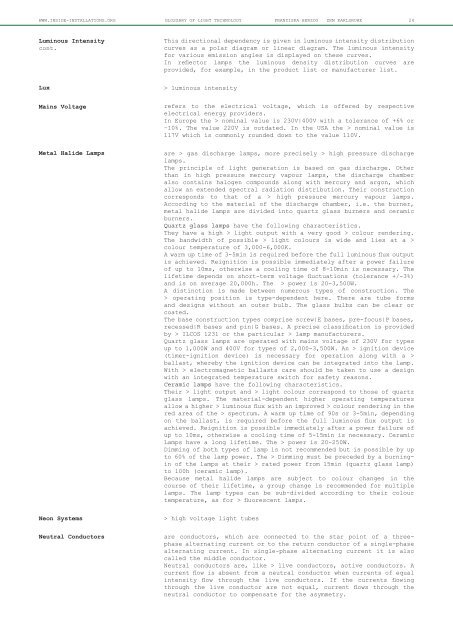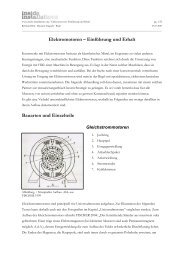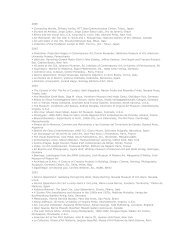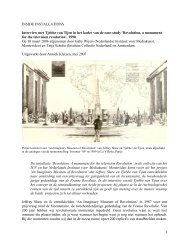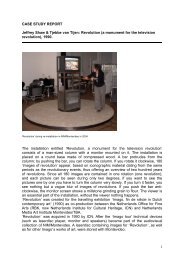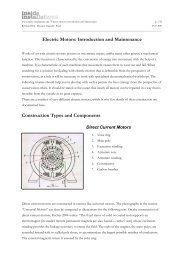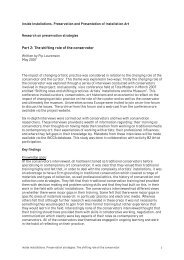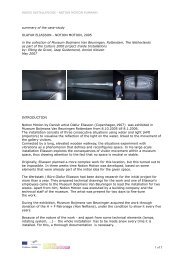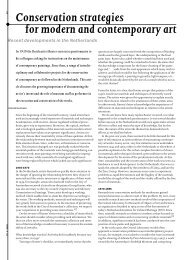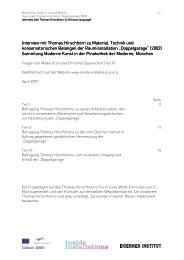GLOSSARY OF LIGHT TECHNOLOGY - Inside Installations
GLOSSARY OF LIGHT TECHNOLOGY - Inside Installations
GLOSSARY OF LIGHT TECHNOLOGY - Inside Installations
You also want an ePaper? Increase the reach of your titles
YUMPU automatically turns print PDFs into web optimized ePapers that Google loves.
WWW.INSIDE-INSTALLATIONS.ORG <strong>GLOSSARY</strong> <strong>OF</strong> <strong>LIGHT</strong> <strong>TECHNOLOGY</strong> FRANZISKA HERZOG ZKM KARLSRUHE 24<br />
Luminous Intensity<br />
cont.<br />
Lux<br />
Mains Voltage<br />
Metal Halide Lamps<br />
Neon Systems<br />
Neutral Conductors<br />
This directional dependency is given in luminous intensity distribution<br />
curves as a polar diagram or linear diagram. The luminous intensity<br />
for various emission angles is displayed on these curves.<br />
In reflector lamps the luminous density distribution curves are<br />
provided, for example, in the product list or manufacturer list.<br />
> luminous intensity<br />
refers to the electrical voltage, which is offered by respective<br />
electrical energy providers.<br />
In Europe the > nominal value is 230V|400V with a tolerance of +6% or<br />
–10%. The value 220V is outdated. In the USA the > nominal value is<br />
117V which is commonly rounded down to the value 110V.<br />
are > gas discharge lamps, more precisely > high pressure discharge<br />
lamps.<br />
The principle of light generation is based on gas discharge. Other<br />
than in high pressure mercury vapour lamps, the discharge chamber<br />
also contains halogen compounds along with mercury and argon, which<br />
allow an extended spectral radiation distribution. Their construction<br />
corresponds to that of a > high pressure mercury vapour lamps.<br />
According to the material of the discharge chamber, i.e. the burner,<br />
metal halide lamps are divided into quartz glass burners and ceramic<br />
burners.<br />
Quartz glass lamps have the following characteristics.<br />
They have a high > light output with a very good > colour rendering.<br />
The bandwidth of possible > light colours is wide and lies at a ><br />
colour temperature of 3,000-6,000K.<br />
A warm up time of 3-5min is required before the full luminous flux output<br />
is achieved. Reignition is possible immediately after a power failure<br />
of up to 10ms, otherwise a cooling time of 8-10min is necessary. The<br />
lifetime depends on short-term voltage fluctuations (tolerance +/-3%)<br />
and is on average 20,000h. The > power is 20-3,500W.<br />
A distinction is made between numerous types of construction. The<br />
> operating position is type-dependent here. There are tube forms<br />
and designs without an outer bulb. The glass bulbs can be clear or<br />
coated.<br />
The base construction types comprise screw|E bases, pre-focus|P bases,<br />
recessed|R bases and pin|G bases. A precise classification is provided<br />
by > ILCOS 1231 or the particular > lamp manufacturers.<br />
Quartz glass lamps are operated with mains voltage of 230V for types<br />
up to 1,000W and 400V for types of 2,000-3,500W. An > ignition device<br />
(timer-ignition device) is necessary for operation along with a ><br />
ballast, whereby the ignition device can be integrated into the lamp.<br />
With > electromagnetic ballasts care should be taken to use a design<br />
with an integrated temperature switch for safety reasons.<br />
Ceramic lamps have the following characteristics.<br />
Their > light output and > light colour correspond to those of quartz<br />
glass lamps. The material-dependent higher operating temperatures<br />
allow a higher > luminous flux with an improved > colour rendering in the<br />
red area of the > spectrum. A warm up time of 90s or 3-5min, depending<br />
on the ballast, is required before the full luminous flux output is<br />
achieved. Reignition is possible immediately after a power failure of<br />
up to 10ms, otherwise a cooling time of 5-15min is necessary. Ceramic<br />
Lamps have a long lifetime. The > power is 20-250W.<br />
Dimming of both types of lamp is not recommended but is possible by up<br />
to 60% of the lamp power. The > Dimming must be preceded by a burningin<br />
of the lamps at their > rated power from 15min (quartz glass lamp)<br />
to 100h (ceramic lamp).<br />
Because metal halide lamps are subject to colour changes in the<br />
course of their lifetime, a group change is recommended for multiple<br />
lamps. The lamp types can be sub-divided according to their colour<br />
temperature, as for > fluorescent lamps.<br />
> high voltage light tubes<br />
are conductors, which are connected to the star point of a threephase<br />
alternating current or to the return conductor of a single-phase<br />
alternating current. In single-phase alternating current it is also<br />
called the middle conductor.<br />
Neutral conductors are, like > live conductors, active conductors. A<br />
current flow is absent from a neutral conductor when currents of equal<br />
intensity flow through the live conductors. If the currents flowing<br />
through the live conductor are not equal, current flows through the<br />
neutral conductor to compensate for the asymmetry.


